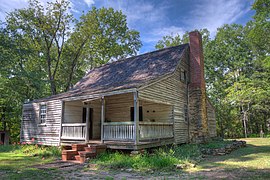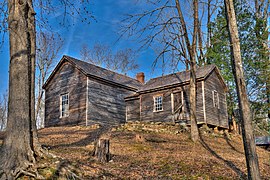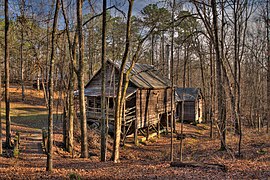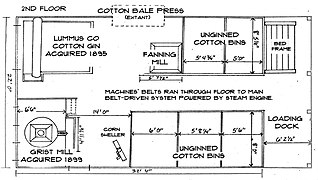Jarrell Plantation
Jarrell Plantation | |
 | |
Location in Georgia | |
| Location | 711 Jarrell Plantation Road, East Juliette, Georgia, U.S. |
|---|---|
| Coordinates | 33°3′7″N 83°43′30″W / 33.05194°N 83.72500°W |
| Area | 200 acres (81 ha) |
| Built | 1847, 1895, 1920 |
| Built by | John Fitz Jarrell, Benjamin Richard "Dick" Jarrell, |
| NRHP reference No. | 73000624[1] |
| Added to NRHP | May 9, 1973 |
The Jarrell Plantation State Historic Site is a former cotton plantation and state historic site in Juliette, Georgia, United States. Founded as a forced-labor farm worked by John Jarrell and the African American people he enslaved, the site stands today as one of the best-preserved examples of a "middle class" Southern plantation.[2] The Jarrell Plantation's buildings and artifacts all came from the Jarrell family, who farmed the land for over 140 years.[3] Located in the red clay hills of the Georgia piedmont, It was added to the National Register of Historic Places in 1973. It is a Georgia state park in Jones County.
History
[edit]Before the Civil War, John Jarrell's farm was one of the half-million cotton farms in the South[4] that collectively produced two-thirds of the world's cotton.[5] Like many small planters, John Jarrell benefited from the development of the cotton gin in 1793 by Eli Whitney, which made it practical to cultivate heavily seeded, short-staple cotton even in hilly, inland areas of Georgia.
John Fitz Jarrell built the first permanent structure on the site in 1847. Typical of antebellum cotton plantations, John Jarrell ran the farm with his family and the forced labor of enslaved Africans. By 1860, Jarrell was enslaving 39 people to work his 660-acre (2.7 km2) farm.[2] Although primarily a cotton plantation, the farm also provided food crops and grazing for livestock. During the turbulent decade of the 1860s, the farm survived a typhoid fever outbreak, Sherman's March to the Sea, emancipation, and Reconstruction.[2] After the Civil War, John Jarrell continued to farm with the help of formerly enslaved people and he increased the farm to nearly 766 acres (3.10 km2).[6][2] The formerly enslaved people began leaving the farm in John Jarrell's final years.[2]
After John's death in 1884 one of John's sons, Benjamin Richard "Dick" Jarrell, gave up a teaching career to return home and build his family home in 1895. Although the farm had been processing sugarcane since 1864,[3] Dick Jarrell expanded the industrialization of the farm by adding a mill complex that eventually included a steam-driven sawmill, cotton gin, gristmill, shingle mill, and planer.[2] In 1920, with the labor of his five sons and two nephews, Dick Jarrell completed a second home, fit for his large family. This house is a 5,000-square-foot (460 m2), 1850s-style home built of heart pine.[7]
In 1974, Dick Jarrell's nine surviving adult children donated the plantation site to the State of Georgia for the preservation of the farm and the education of future generations about their heritage. The State of Georgia's Department of Natural Resources operates the now 200-acre (810,000 m2) historic site and opens it to the public Thursday through Sunday.[2] The site's buildings and structures include the farmhouse, a sawmill, cotton gin, gristmill, shingle mill, planer, sugar cane press, syrup evaporator, workshop, barn and outbuildings.
Images
[edit]-
site map
-
panoramic view
-
Visitor Center
-
1847 house
-
1895 house
-
barn
-
Gin house
-
floor plan of the mill complex
See also
[edit]References
[edit]- ^ "National Register Information System". National Register of Historic Places. National Park Service. July 9, 2010.
- ^ a b c d e f g Georgia State Parks – Jarrell Plantation Historic Site
- ^ a b Sugar Cane – Operations – Southern Matters
- ^ Cotton South
- ^ United States and Canada, 1800–1900 A.D. | Timeline of Art History | The Metropolitan Museum of Art
- ^ Gunn, Victoria Reeves (1974). Jarrell Plantation: A History. Georgia: Georgia Department of Natural Resources. pp. a35.
- ^ Jarrell 1920 House homepage
External links
[edit]- Jarrell Plantation Historic Site - official site
- Houses on the National Register of Historic Places in Georgia (U.S. state)
- State parks of Georgia (U.S. state)
- Farm museums in Georgia (U.S. state)
- Museums in Jones County, Georgia
- Protected areas established in 1974
- Protected areas of Jones County, Georgia
- 1974 establishments in Georgia (U.S. state)
- Houses in Jones County, Georgia
- Historic districts on the National Register of Historic Places in Georgia (U.S. state)
- National Register of Historic Places in Jones County, Georgia
- Cotton plantations in Georgia (U.S. state)










